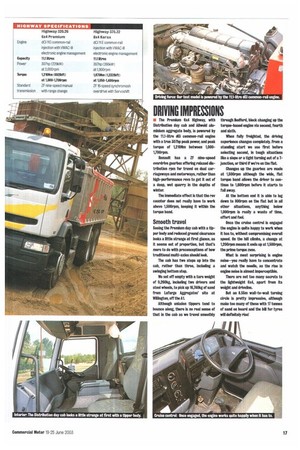DRIVING IMPRESSIONS
Page 17

If you've noticed an error in this article please click here to report it so we can fix it.
The Premium 6x4 Highway, with Distribution day cab and Aliweld aluminium aggregate body, is powered by the 11:I-litre del common-rail engine with a true 307hp peak power, and peak torque of 1,210Nm between 1,0001,70Orpm.
Renault has a ZF nine-speed overdrive gearbox offering relaxed distribution rpm for travel on dual carriageways and motorways, rather than high-performance revs to get it out of a deep, wet quarry in the depths of winter.
The immediate effect is that the rev counter does not really have to work above 1,500rpm, keeping it within the torque band.
Smooth travel Seeing the Premium day cab with a tipper body and reduced ground clearance looks a little strange at first glance, as it seems out of proportion, but that's more to do with preconceptions of how traditional multi-axles should look.
The cab has two steps up into the cab, rather than three, including a swinging bottom step.
We set off empty with a tare weight of 9,260kg, including two drivers and steel wheels, to pick up 16,740kg of sand from Lafarge Aggregates' site at Willington, off the Al.
Although unladen tippers tend to bounce along, there is no real sense of that in the cab as we travel smoothly
through Bedford, block changing up the torque-based engine via second, fourth and sixth.
When fully freighted, the driving experience changes completely. From a standing start we use first before selecting second, in tough situations like a slope or a tight turning out of a Tjunction, or third if we're on the flat.
Changes up the gearbox are made at 1,500rpm although the wide, flat torque band allows the driver to continue to 1,600rpm before it starts to fall away.
At the bottom end It is able to lug down to DOOrprn on the flat but in all other situations, anything below 1,000rpm is really a waste of time, effort and fuel.
Once the cruise control Is engaged the engine is quite happy to work when it has to, without compromising overall speed. On the hill climbs, a change at 1,200rpm means it ends up at 1,500rpm, the prime torque zone.
What is most surprising is engine noise—you really have to concentrate and watch the needle, as the rise in engine noise is almost imperceptible.
Mere are not too many secrets to the lightweight 6x4, apart from its weight and driveline.
But an 8.55m wall-to-wall turning circle is pretty impressive, although make too many of those with 17 tonne.s of sand on board and the bill for tyres will definitely rise!














































































































































































